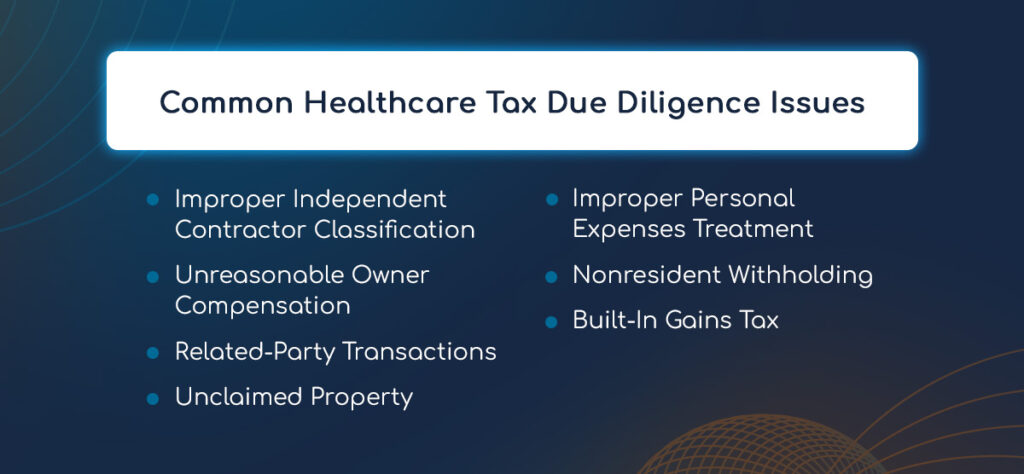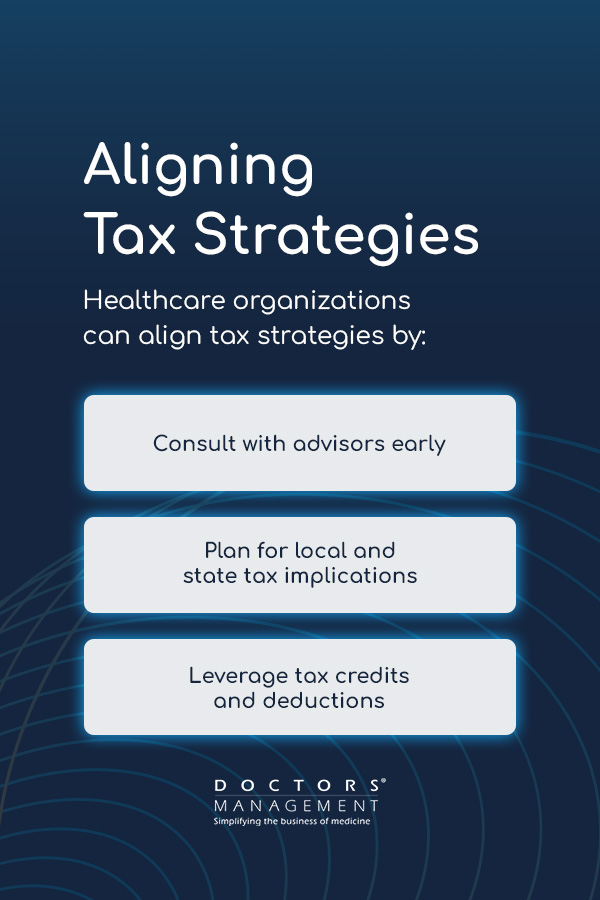January 10, 2025
Navigating Tax Due Diligence in Healthcare Mergers and Acquisitions
Mergers and acquisitions (M&A) provide many strategic healthcare opportunities. However, these transactions require much collaboration with financial experts and tax due diligence professionals. Some potential problems have tax consequences that can harm negotiations or deal processes.
By identifying these common problems, understanding the importance of due diligence, and creating a smooth due diligence process, a healthcare facility can seek profitable opportunities and foster business growth. Learn more about tax due diligence from the buyer’s perspective and seller’s position, including benefits and healthcare-specific challenges to note.
What Is Due Diligence in M&A?
Understanding tax due diligence in healthcare acquisitions involves ensuring a facility is making the best decisions in order to maximize opportunities, adding value to an M&A transaction. The due diligence process identifies liabilities and opportunities and ensures healthcare compliance with tax regulations. Generally, there are five types of due diligence within the M&A process — tax, legal, financial, operational, and information technology due diligence.
Tax due diligence refers to the process of examining a facility’s tax affairs, ensuring the facility has paid all liabilities in full. This type of due diligence evaluates how merger opportunities will affect the new entity’s tax liabilities after the transaction is complete.
Tax due diligence also determines where a business can reduce tax burdens during the merger process. Businesses must understand these tax implications before completing a deal and form a post-merger strategy so the business can continue operating seamlessly and legally.
Common Healthcare Tax Due Diligence Issues

In order to mitigate risks and form comprehensive due diligence and post-merger processes, facilities should understand common tax due diligence issues. In the healthcare industry, common problems are:
1. Improper Independent Contractor Classification
Employers often misclassify employees as independent contractors. Some employers purposefully misclassify their employees in this category in order to avoid paying payroll taxes to the state or federal government.
Alternatively, there may be times when an employer misclassifies an independent contractor based on time worked, service types, or pay levels. However, employers that misclassify their employees, intentionally or not, will be subject to taxes and penalties that could succeed to the buyer.
2. Unreasonable Owner Compensation
Some owners of flow-through entities and C corporations minimize their salaries in order to achieve more favorable non-wage distributions. The IRS evaluates whether an owner’s salary is acceptable by evaluating business activities, profits, and involvement from shareholders. If the IRS decides an owner’s salary is too low, the buyer may be subject to this tax. If the IRS determines an owner’s salary is too high, the state revenue service or IRS may reclassify a portion to dividends.
3. Related-Party Transactions
When two parties with a preexisting connection form a new transaction, they create a related-party transaction. Transactions like lending arrangements, leases, common cost allocations, asset transfers, sales, and guarantees can be related-party transactions. These transactions can present a problem if an organization uses them to receive additional cash from the business, typically by disguising compensation to avoid payroll taxes.
4. Unclaimed Property
Every state has its own statute governing unclaimed property and how long checks can remain dormant before an organization must return them to the state. Some examples include patient overpayments, payroll checks, unclaimed or uncashed refund checks, vendor checks, or insurance overpayments. Although some providers can apply overpayments to future appointment balances, problems arise in the case of nonrecurring patients.
5. Improper Personal Expenses Treatment
C corporations and S corporations can face challenges if an owner uses a corporate account to cover personal expenses. In some cases, governments consider these payments to be compensation, subjecting the payments to payroll taxes. Buyers may be held liable for owed amounts after an acquisition if the seller does not address these taxes, penalties, or interest.
6. Nonresident Withholding
Local and state governments can tax residential income and nonresidential income that derives from local or state sources. Failing to comply with withholding regulations can result in owners covering the specific withholding amount along with penalties and interest.
7. Built-In Gains Tax
In some states, corporations that change status or acquire C corporation assets in tax-free transactions could be subject to built-in gains tax, as well as imposed tax on shareholders from the transaction. Buyers can leverage this potential liability knowledge to negotiate with the seller, ensuring the buyer does not inherit that liability.
8. IRS Regulations
IRS regulations require that sales proceeds be allocated to defined asset Classes or groups; the various asset classes are typically subjected to different tax rates.
Specific Healthcare Tax Considerations

Healthcare owners and facilities must administer additional care when navigating tax due diligence to avoid business challenges and obtain anticipated acquisition value. Due to the complex nature of the industry, healthcare M&A due diligence varies slightly from other industries. The healthcare industry faces unique tax obstacles that other sectors do not need to navigate.
For example, unclaimed property in healthcare spans beyond the typical scope. Healthcare facilities commonly experience problems with patient deposits, refunds, trust fund accounts, insurance reimbursements, and deposits for medical equipment. Problems with patient balances can also arise in the form of duplicate payments resulting from complex payment processes.
Sales tax can also be overwhelming in the healthcare industry. Sales tax rates and regulations vary across jurisdictions, and the unique range of services and products in the industry contribute to uncertainty. Healthcare facilities may offer telehealth services, in-person services, medical equipment leases, medical supply usage, and personal property transfers, all of which require consideration.
Understanding the Buyer’s Perspective
People often consider M&A from the buyer’s perspective because the buyer can be subject to financial obligations they were unaware of if they don’t ensure due diligence before completing a deal. Buyers typically ensure thorough due diligence by analyzing tax implications and scrutinizing the seller’s financials.
Buyers will scrutinize the seller’s financial information by evaluating tax records, statements, and similar documents. This step involves analyzing data on the company’s historical performance, forming assumptions for growth and future profitability, and evaluating future industry projections. Potential buyers want to understand their expected cash flow, so they will typically consider factors such as:
- Current cash flow and cash flow sustainability.
- Short- and long-term expenditures.
- Initial cash investments and working capital.
- Replacement and fixed-asset costs.
In order to determine tax implications, buyers assess potential liabilities associated with the company. In some cases, buyers may evaluate tax positions or regulation compliance. This part of a buyer’s due diligence allows them to identify potential risks and assess their severity. As such, they can determine whether they could alter the value or structure of a deal.
Due to the complexity of healthcare M&A, buyers must understand the procedures and policies critical to the company and patient care. In order to evaluate compliance and ensure the buyer can maintain compliance, they will often consider common elements of medical compliance challenges, including:
- Data management practices, including stewardship roles and policies to ensure data standardization, integrity, and accuracy.
- Cybersecurity and cyber resiliency to ensure the protection of patient information.
- Healthcare regulations to minimize legal risks and demonstrate compliance with appropriate organizations and standards.
Aligning Tax Strategies

Crafting tax-efficient acquisition structures is beneficial to buyers and sellers. Integrating various tax strategies with business goals can ensure a company remains compliant and helps maximize value. Healthcare organizations can align tax strategies by:
- Consulting with advisors early: Legal advisors, tax professionals, and financial advisors are crucial to the M&A process. Initiating conversations with these entities early can guide organizations to align tax strategies with business goals while navigating M&A complexities to optimize their outcomes.
- Planning for local and state tax implications: Healthcare entities operating across multiple states must assess specific tax laws that can impact acquisition structure. Assets such as medical equipment may be subject to sales tax in various jurisdictions, and some states may have sales tax for some care services. Additionally, buyers may encounter licensing or regulatory fees in some jurisdictions.
- Leveraging tax credits and deductions: Buyers may identify accelerated depreciation opportunities on some assets to reduce taxable income after the acquisition. Various tax credits, such as those for energy efficiency, hiring, or research, can offset some liabilities. Leveraging these credits can improve cash flow and make the acquisition more valuable. Furthermore, many tax credits rely on regulation adherence, empowering organizations to ensure industry compliance and give buyers peace of mind.
Ensuring a Smooth M&A Due Diligence Process
Proactive steps for creating a smooth process include:
- Ensuring accuracy and transparency: At the beginning of the M&A process, it’s essential for organizations to enhance accuracy and transparency with buyers and internal teams. Organizations should establish project goals in order to determine what the company hopes to gain from the acquisition. Setting and communicating these goals can align teams and identify necessary resources to reach these goals.
- Analyzing company financials: Organizations must evaluate their financial records in order to ensure reliability and accuracy. Healthcare facilities should evaluate income statements, balance sheets, inventory schedules, and debt information. Buyers will likely request this information, so having it ready for analysis and ensuring accuracy can move the process along smoothly.
- Gathering necessary documents and tax data: All necessary documents verify practice compliance and allow buyers to better understand how a company works. Documents such as site visits, interviews with key employees, intellectual property rights, and contracts can highlight an organization’s ability to meet industry standards and ensure operational legality.
- Fostering open communication: Facilities must coordinate between legal, financial, and tax advisors in order to ensure a smooth due diligence process. Fostering open communication can reduce discrepancies and demonstrate a company’s commitment to the due diligence process. Coordination between advisors can help identify gaps, allowing businesses to address issues promptly.
- Practicing proactive risk management: Risk management is critical in the due diligence process. Organizations must evaluate market, operational, and financial risks. Hidden debts, financial instability, technology issues, and negative market reactions to the business change can drastically impact the success of M&A. A proactive risk management approach aims to identify these potential risks so an organization can avoid them or employ mitigation strategies quickly if a problem occurs.
- Creating a due diligence checklist: Using a comprehensive checklist keeps teams on track and aligns the organization’s actions with expectations. This list can empower healthcare facilities to gather all necessary documents ahead of time and follow a proper path to enhance their chance of success. A due diligence checklist should contain facility-specific and industry-standard information to guide the M&A process.
Benefits of Proactive Engagement in M&A Tax Due Diligence
Due diligence is critical for successful M&A outcomes. This process ensures compliance and organization potential, both of which are vital to company growth and success. Although due diligence is a necessary process component, it also delivers several advantages:
- Mitigating risks: Proactive due diligence empowers teams to identify risks early and resolve them quickly to alleviate partner concerns. Addressing or avoiding potential risks can reinforce trust between parties and instill confidence in a buyer.
- Minimizing disruptions and delays: Streamlining the due diligence process involves having the necessary documents and company information at the ready. Businesses that prepare all necessary documents before the transaction can minimize disruptions or delays associated with obtaining this information or addressing issues that arise.
- Enhancing transaction value: Due diligence empowers buyers and sellers to ensure transaction accuracy and reliability. Leveraging recent business information, industry predictions, and historical performance data can grant both parties better insight into organizational value and growth opportunities.
- Identifying and resolving tax issues: A significant advantage of proactive due diligence is the ability to identify and resolve tax issues. For sellers, identifying and addressing these issues can help organizations maintain compliance and move the acquisition process along faster. For buyers, identifying and resolving tax issues can help them save on costs and better understand their obligations post-acquisition.
- Strengthening trust with partners and investors: Proactive due diligence is a great way to strengthen trust with investors and partners. A proactive process enhances communication between industry professionals and advisors, building confidence and aligning strategies with business goals and values. Efficient due diligence can boost organizational reputation and highlight a company’s credibility, fostering a culture of positivity and growth.
- Demonstrating accountability and thoroughness: Engaging in an efficient and proactive due diligence process highlights an organization’s dedication to the acquisition. A company that investigates records and ensures accuracy shows partners that the team values their relationship and wants to strengthen the relational bond. These characteristics can also impact patient and advisor relationships.
Build Complete, Long-Term Compliance Programs With DoctorsManagement, LLC
Due diligence is a critical aspect of healthcare M&A. By developing a proactive approach to addressing potential problems and finding reliable partners to guide you through the process, you can increase acquisition value and achieve more desirable outcomes.
DoctorsManagement, LLC empowers healthcare professionals to focus on patient care and simplify the business of medicine. As a full-service consulting firm, we guide healthcare professionals and physicians in order to boost productivity, increase profits, mitigate compliance risks, and reduce team and provider stress. Our team solely focuses on the healthcare industry, and our in-house experts can help small and large practices in various specialties enhance operations and performance.
Our consulting services can guide you through strategic planning, practice management, transitions, and more. Our experts can also help you navigate compliance, healthcare analytics, and industry regulations in order to foster proactive due diligence engagement and reach successful outcomes.
Please contact our team to learn how we can help your business.







